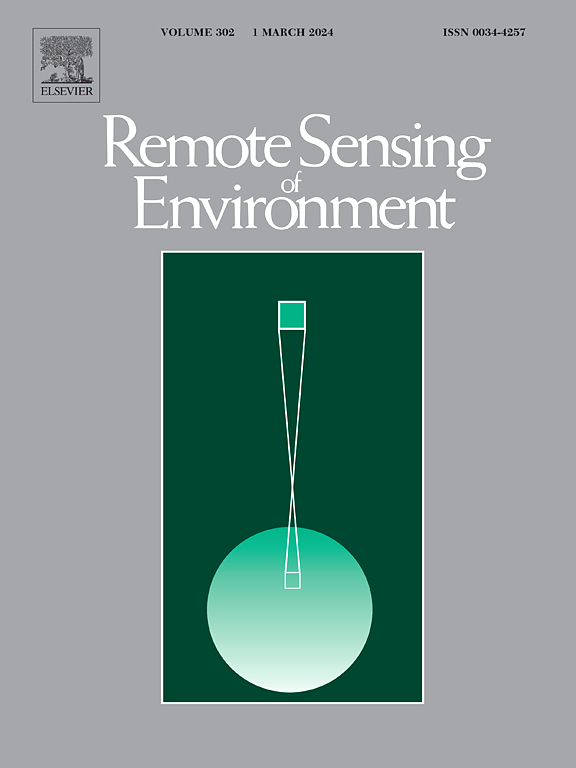使用ICESat-2光子和多源卫星观测进行建筑高度制图的灵活框架
IF 11.1
1区 地球科学
Q1 ENVIRONMENTAL SCIENCES
引用次数: 0
摘要
建筑高度是理解城市形态和社会经济活动之间复杂关系的纽带。随着遥感技术的出现,从卫星观测得到的建筑高度图在过去几年已经成为可能。然而,缺乏高精度样本数据对大尺度(区域或全球)建筑高度制图造成了重大限制,特别是在发展中地区。为了解决这个问题,我们提出了一个灵活的制图框架,利用冰、云和陆地高程卫星-2 (ICESat-2)数据获得精确的建筑物高度样本,用于建筑物高度估计。首先,我们使用随机样本共识(RANSAC)线性拟合和布模拟滤波等先进算法从ICESat-2光子计算建筑物高度。然后,将高度信息聚合到最优大小的网格单元中,构建大规模建筑高度样本;最后,借助ICEsat-2和Sentinel数据的其他卫星观测数据以及数字地面模型(DSM)提供的网格高度信息,我们使用随机森林回归模型绘制了两个特大城市(即纽约和深圳)的建筑高度图。我们的研究结果表明,与其他研究相比,使用ICESat-2数据估算建筑物高度通常具有较高的精度,显示出支持使用卫星观测进行大规模建筑物高度制图的巨大潜力。在对网格内的建筑比例及其大小进行综合敏感性分析后,我们发现建筑物高度映射的最佳网格尺寸约为300米。总体而言,地图上的建筑高度是可靠的,纽约和深圳的平均绝对误差(MAE)相对较低,分别为2.69 m和3.87 m,与之前的研究相似或更好。通过利用ICESat-2数据提供的高精度高程数据,我们提出的方法可以有效地在建筑高度信息有限的地区收集样本,显示出大规模建筑高度监测和支持未来城市研究的巨大潜力。本文章由计算机程序翻译,如有差异,请以英文原文为准。
A flexible framework for built-up height mapping using ICESat-2 photons and multisource satellite observations
Built-up heights serve as a nexus in understanding the complex relationship between urban forms and socioeconomic activities. With the advent of remote sensing technology, built-up height mapping from satellite observations has become available over the past years. However, the absence of high-precision sample data poses a significant limitation to built-up height mapping at large (regional or global) scales, particularly in developing regions. To address this issue, we proposed a flexible mapping framework to derive precise building height samples using the Ice, Cloud, and Land Elevation Satellite-2 (ICESat-2) data for built-up height estimation. First, we calculated building heights from ICESat-2 photons using advanced algorithms such as Random Sample Consensus (RANSAC) linear fitting and cloth simulation filtering. Then, we constructed large-scale built-up height samples by aggregating the height information into grid cells with optimal size. Finally, aided by these grids with height information from ICEsat-2 and other satellite observations from Sentinel data as well as the digital surface model (DSM), we mapped built-up heights in two mega-cities (i.e., New York and Shenzhen) using the random forest regression model. Our results demonstrate building height estimation using ICESat-2 data generally exhibits in relation to other studies high accuracy, showing great potential to support large-scale built-up height mapping using satellite observations. We found the optimal grid size for built-up height mapping is around 300 m, after a comprehensive sensitivity analysis regarding the building fraction within the grid and its size. Overall, the mapped built-up heights are reliable, with relatively low mean absolute errors (MAE) of 2.69 m in New York and 3.87 m in Shenzhen, similar to or better than previous studies. By leveraging high-precision elevation data provided by the ICESat-2 data, our proposed approach can effectively collect samples in regions with limited information on building heights, showing great potential for large-scale built-up height monitoring and supporting future urban studies.
求助全文
通过发布文献求助,成功后即可免费获取论文全文。
去求助
来源期刊

Remote Sensing of Environment
环境科学-成像科学与照相技术
CiteScore
25.10
自引率
8.90%
发文量
455
审稿时长
53 days
期刊介绍:
Remote Sensing of Environment (RSE) serves the Earth observation community by disseminating results on the theory, science, applications, and technology that contribute to advancing the field of remote sensing. With a thoroughly interdisciplinary approach, RSE encompasses terrestrial, oceanic, and atmospheric sensing.
The journal emphasizes biophysical and quantitative approaches to remote sensing at local to global scales, covering a diverse range of applications and techniques.
RSE serves as a vital platform for the exchange of knowledge and advancements in the dynamic field of remote sensing.
 求助内容:
求助内容: 应助结果提醒方式:
应助结果提醒方式:


